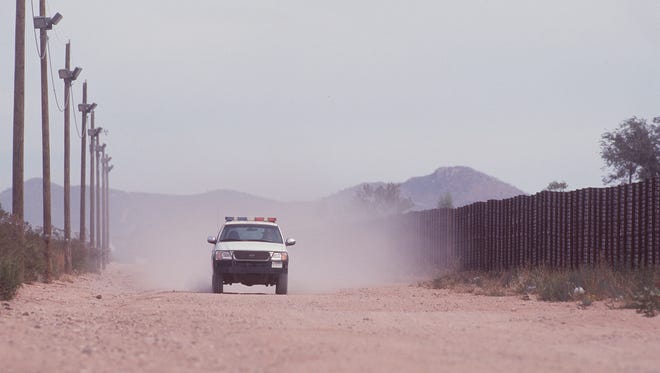CBP to disband Border Patrol units accused of cover-ups in Arizona
 Laura Daniella Sepulveda
Laura Daniella Sepulveda
U.S. Customs and Border Protection issued a memo last week announcing that Border Patrol Critical Incident Teams, which have been accused of covering up official wrongdoing, will no longer be used in the processing of critical incidents involving CBP agents starting in October.
The announcement comes months after congressional Democrats urged the Government Accountability Office in a letter to investigate the use of the critical incident teams to process critical incident scenes.
The letter, sent in January, was prompted by concerns from civil rights organizations that claim the units have been used to cover up incidents involving excessive violence by CBP agents.
More than 200 U.S. citizens and noncitizens have been killed by CBP agents since 2010, according to the Southern Border Communities Coalition, an organization that says it is aimed at eradicating perilous border policies that have put human rights of migrants at stake.
These numbers are disputed as they are tallied from media coverage and press releases. According to a 2022 report from the Government Accountability Office, CBP does not reliably report migrant deaths despite implementing a program in 2017 that is meant to help the agency track death reports of individuals in its custody.
According to the Government Accountability Office, "Border Patrol has not collected and recorded, or reported to Congress, complete data on migrant deaths, or disclosed associated data limitations," the report states.
CBP is the largest federal law enforcement agency in the country. No Border Patrol agent has ever been convicted in an on-duty killing incident since the creation of the agency in 2003.
The memo dated May 3 states that the Office of Professional Responsibility (OPR), a branch dedicated to ensuring accountability of professional misconduct among CBP employees, will be fully in charge of the investigation of critical incidents.
Previous guidelines required that the use of critical incident teams be done under the supervision of an OPR commander. Effective Oct. 1, 2022, the OPR will be assigned complete responsibility for that function, the memo stated.
According to the memo, the Department of Homeland Security will provide the OPR with the resources to hire additional personnel to take on the task.

"While OPR is funded to bring as many as 350 new personnel on board using this two-year budget authority, initial estimates are a significant number of new personnel must be hired, and trained, to ensure OPR is able to carry out its critical incident response function," CBP Commissioner Chris Magnus said in the memo.
In a news release, the Southern Border Communities Coalition commended the CBP and Magnus for being "responsive to community concerns" and haltering a practice that had been carried out in secrecy for more than three decades.
A demand for accountability
In December 2021, a woman from Nogales, Arizona, filed a claim against CBP after she survived being shot in the head by a Border Patrol agent.
Marisol García Alcantara, 37, was suspected of trying to enter the U.S. illegally in June 2021 after CBP agents found her sitting in the back seat of a vehicle they detained at the border.
According to García's attorneys, CBP policies prohibit the use of firearms solely to disable a vehicle, yet an agent fired his gun at the vehicle and into García's head.
After surviving the incident and being released from the hospital, García was deported. As a consequence of the shooting, García is at constant risk of seizures caused by the bullet fragments lodged in her brain, she told The Associated Press.
In February, a similar incident occurred north of Douglas when a Border Patrol agent fatally shot a male migrant, later identified as Carmelo Cruz-Marcos, a few miles north of the Mexican border.
The Cochise County Sheriff's Office released a statement on Facebook reporting Cruz-Marcos' death a few days after the incident but did not provide details about what caused his injuries.
The CBP later confirmed in a statement that an agent from the Douglas Border Patrol Station Horse Patrol Unit had fatally shot Cruz-Marcos after he allegedly tried to escape from being apprehended.
The Arizona Department of Public Safety helped retrieve Cruz-Marcos' body after the shooting. A few days later, the Pima County Medical Examiner’s Office released findings from its post-mortem examination, which confirmed he died of several gunshot wounds from the agent on his chest and abdomen.
The Mexican Consulate confirmed Cruz-Marcos was Mexican.
Alba Jaramillo, Southern Border Communities Coalition co-chair and executive director of Arizona Justice for Our Neighbors, a United Methodist Immigration Ministry, had previously said to The Arizona Republic that "the secrecy and impunity" of these acts is a "public safety concern."
"We demand accountability and transparency. We demand justice for this person's family," Jaramillo previously told The Republic following the man's death.
The Southern Border Communities Coalition called for the GAO to continue investigating the CBP to get a full account of the actions of the critical incident teams and assess any obstructions of justice.
Republic reporter Angela Cordoba Perez contributed to this article.
Reach breaking news reporter Laura Daniella Sepulveda at lsepulveda@lavozarizona.com or on Twitter @lauradNews.
Support local journalism. Subscribe to azcentral.com today.